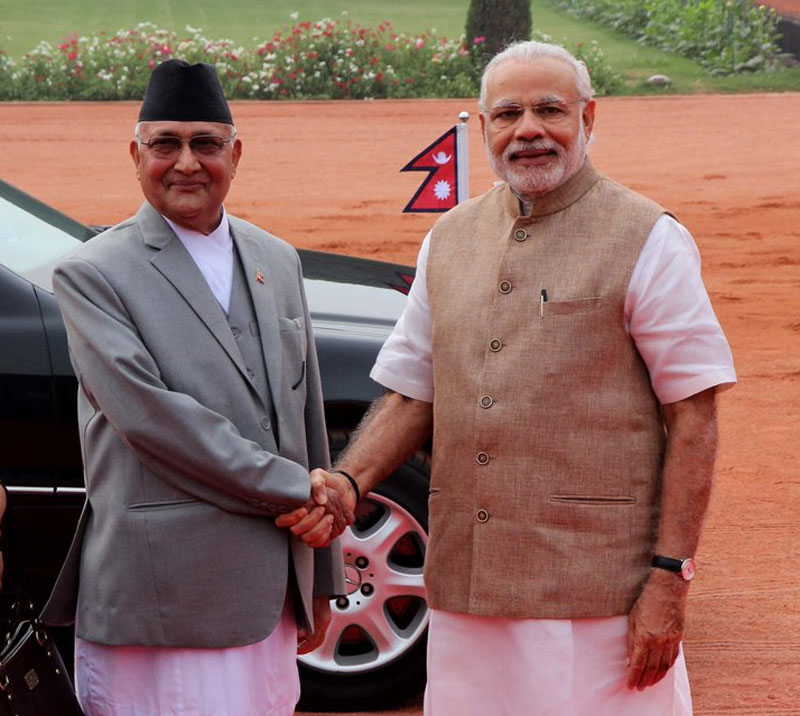 By Rajeswari Pillai Rajagopalan (12 April 2018) – Nepal’s newly elected Prime Minister, KP Sharma Oli, in keeping with tradition, made his first foreign trip to India last week. Considering that he is generally considered “pro-China,” this must come as a relief to the Indian government.
By Rajeswari Pillai Rajagopalan (12 April 2018) – Nepal’s newly elected Prime Minister, KP Sharma Oli, in keeping with tradition, made his first foreign trip to India last week. Considering that he is generally considered “pro-China,” this must come as a relief to the Indian government.
Moreover, going by his press briefing after his return, it appears that the visit went well, which is yet another surprise. He said that the visit “has increased confidence between India and Nepal and bilateral relations will move forward in a new direction on the basis of equality, mutual respect and interest and enhance cooperation.” He also claimed that the visit has “helped in clearing misunderstanding and mistrust and strengthening mutual trust and understanding.”
The optics during the meeting were also suggestive of a successful meeting. Indian Prime Minister Narendra Modi, congratulating Oli on the successful elections in recent months, said that his principle of “Sabka Saath, Sabka Vikas” (Together with all, development for all) and Oli’s vision of “Samruddha Nepal, Sukhi Nepal” (Prosperous Nepal, Happy Nepal) were complimentary in nature. Modi went on to say that, India will cooperate with Nepal in its journey towards greater prosperity but also thoughtfully added that such cooperation “will be based on the priorities and requirements set by the Government of Nepal.”
New Delhi must be hopeful that this successful visit will undo the damage done by the “unofficial blockade” of 2016. The multi-month blockade resulted in significant hardships for the people of Nepal – it affected everything from petroleum to medicines and earthquake relief material, leading to huge price rise for basic commodities in Nepal. The Indian government, taking up the cause of Madhesis in an aggressive manner and asking Nepal to amend the constitution, created huge resentment towards New Delhi.
Complicating this complex relationship is the China factor. In the face of rising anti-India sentiment, China has only been too happy to step into the role that India played earlier. Further, Nepal’s support for China’s Belt and Road Initiative widened the trust gap between Kathmandu and New Delhi.
Nevertheless, Oli’s visit may be the first step towards repairing the damage generated in the last few years. Oli’s second tenure in office is also seeing a far stronger leader who has been able to consolidate his power, although traction was initially gained on an anti-India platform. Since coming to office, he has taken some populist and smart decisions that affect the people, for instance on the power situation within the country. Parts of Nepal used to witness 16-20 hours if power cuts everyday, but Oli was able to take action on this and improve the situation. If India wants to win over Nepal and let it not slip into China’s grasp entirely, this is the time and Oli might be the man to deliver, despite his alleged pro-China leanings.
Unlike Oli’s previous visit to India when no joint statement was issued, this time around, not only was one issued but it outlines a bilateral cooperative agenda across three key sectors of rail connectivity, developing inland waterways, and agriculture. There were three separate joint statements issued on each laying out in detail the tasks ahead. Cross-border rail connectivity in particular will be significant in strengthening people-to-people and economic linkages between the two countries. During Oli’s visit, the two prime ministers decided to construct a new electrified railway line, linking Raxaul in India and Kathmandu in Nepal. India has agreed to finance this project.
Similarly, the agreement on inland waterways is vital in establishing access to sea for the landlocked Nepal. The joint statement specifically noted the two prime ministers’ agreement “to develop the inland waterways for the movement of cargo … providing additional access to sea for Nepal.” The third key sector, agriculture, also offer big promises, with collaborative ventures in a number of areas. The two sides have also agreed to encourage exchanges between the Indian Council for Agricultural Research (ICAR) and the Nepal Agricultural Research Council (NARC).
New Delhi is clearly concerned about China’s growing clout in Nepal. It must be noted that Beijing has also focused on regional connectivity and hydropower projects in its dealings with Kathmandu, and therefore India’s ability to deliver on the three key sectors will be assessed against those of China, however fair or unfair that might be. China’s involvement for a couple of decades in mini hydropower projects is noteworthy.
To China, Nepal is a strategic buffer. Nepal’s importance to China comes more from the thousands of Tibetans living in the country and therefore, “controlling Tibetan activism there is a priority for Beijing.” The India angle comes as a close second political objective, even though it is often presented as a singular or the dominant one.
Oli’s visit offers India an opportunity to repair the damage it caused in recent years. India has to focus on implementation and delivery on the three key sectors identified during the visit. That means India must rectify the terrible track record that it suffers in project implementation. The four Integrated Check Posts (ICP) on the India-Nepal border is a case in point. Several problems from both sides may have caused the delays, but India’s overall record in completing projects does not bode well. If it wants to truly address growing competition from China in its neighborhood in general and Nepal in particular, India will have to perform better this time around.
This article first appeared in The Diplomat


